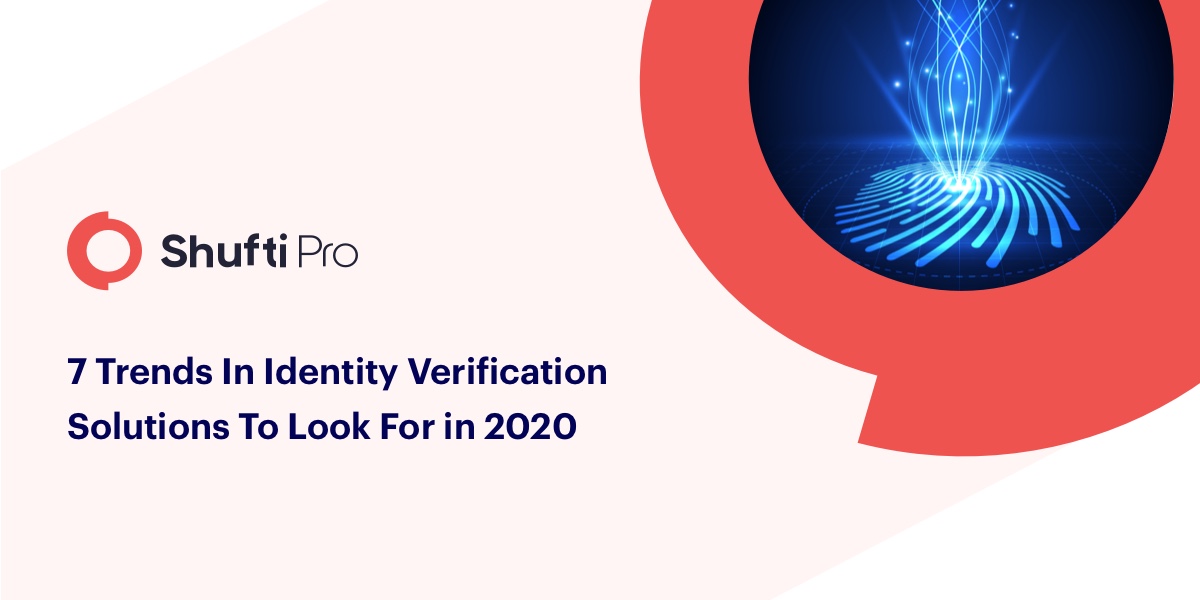7 Trends in Identity Verification Solutions to look for in 2020

Internet is an anonymous space where people can hide their identities and come up with bizarre pseudo names. With the increasing online services, identifying identities digitally is becoming crucial than ever before. But verification should be done in a way that does not impact the user’s experience. Security has become the topic of utmost interest for all businesses due to the increasing number of recent high-profile data breaches that have affected millions of consumers and organizations. Identifying individuals online is an essential component of KYC and AML regulations as well. Organizations can benefit from remaining compliant by having proper identity verification checks in place. It also increases customer confidence in the business that they are taking proper measures to protect their private data.
As identity thieves are becoming more sophisticated, organizations are arming themselves with technologies to protect themselves against viruses, malware, and other frauds. Identity authentication technology has evolved using biometrics as a stronger security measure to fight back fraudulent activities. As well as unequivocally answer the question that the customer is who he says he is before starting to deal with him.
The Rise of Identity Verification Solution for businesses
As financial frauds are clamping up, the demand for identity verification technology is also increasing. 50% of stolen identities were reported to be used in various business crimes in recent years. According to a report, UK based company lost £1.2 billion falling in the pit of frauds last year. The identity verification market is expected to reach $12.8 billion by 2024 at the Compound Annual Growth Rate (CAGR) of 16.0% during the upcoming period. As many businesses have drowned and faced major losses due to falling in such frauds so having proper ID check is a must-have. The digitizing of the world has bought so many scams to light and urged businesses to take stringent measures for cybersecurity. Digital communications are preferred as no one has time for face to face interactions so is the case with identity checks. Manual identity verification requires a lot of time and is now a thing of the past.
The presence of users on the internet has significantly raised the number of digital frauds, causing millions of losses for individuals and businesses every year. Regulatory authorities have made it mandatory for every business to have sound identity authentication checks integrated into their system to put a halt on money laundering, identity theft, financing of terrorists, etc. KYC (know your customer) regulations are there to know who exactly you are dealing with, by verifying their original documents, address, and biometrics. AML (anti-money laundering) regulations around the world have placed stringent compliance regulations on the investment companies as well as other financial institutions.
Trends in Identity Verification
Some of the latest trends in this technology are taking it to new heights. Here are the top trends in this technology that are changing the ID verification sphere:
- KBA is Moving Out
The authentication process by having possession over data is no longer considered a sufficient solution. KBA and SSN verification are going out of the picture as they are proving to be a week security system. Recent data leaks have also validated this fact. So businesses are looking for better solutions to perform authentication methods. A phone number to identify allows a business to authenticate the user accessing a system and halting fraudsters from using leaked data.
- Comprehensive Integration:
Financial institutes are becoming aware of the need for systems to fully integrate with financial institutes existing core technologies. Most of the businesses are not considering alterations in their core processors, finding it way too expensive. But latest identity verification solutions do not require any additional hardware to be installed. They can be easily integrated with the current processors cutting short the cost for businesses. ID verification system can easily be integrated and does not create bugs that are formed due to incompatibility issues upon implementation. The time required for diminishing such bugs out of the system is also saved. As time is money for businesses so this technology is both time and cost-effective.
- Biometric Technology
Biometric verification is not just a buzzword in identity verification but this technology is a milestone achieved in mitigating risks of forgery and scams. By identifying a person through his unique facial features or fingerprints, fraudsters can be authenticated before giving access to the system. It is becoming increasingly powerful with every new iteration. Biometric technology, depending on applications, allows a user to authenticate himself using geolocation, fingerprints, iris scan, face recognition, and other biometrics that are unique to a person.
This technology is becoming more prevalent. Face verification technology provides seamless authentication just like taking a ‘selfie’. No contact or additional hardware is required in this. That is why it is being widely adopted. 3D liveness detection adds an extra layer of security. Liveness Detection is a process that assures the live physical facial presence of a person is validated at the time of biometric authentication. It is an anti-spoofing measure to fight back all kinds of frauds to deceive such a system. This technology is vetted and became mainstream in identity verification solutions to ensure greater accuracy without using additional technology.
- Two Factor Authentication
Securing your systems with passwords only is known for years but we know these can be cracked easily in this digitized world. It is even difficult to memorize and change passwords frequently. It has become a fantasy that only strong passwords can now protect us, as hackers regularly breaking into the systems and releasing passwords. As our accounts are interconnected by Emails, it becomes easy for hackers to crack the password of one and gain access on all. So the solution for it is two-factor authentication, which lets a user know when someone is trying to gain access on any of their accounts. Like Gmail account is asking you every time you are signing in from different browsers if it was you. The basic idea is just a secure second option that authenticates without making it inconvenient for the user. It’s easy adding your mobile number and add a secret code sent to you every time you are logging in. It is instant and adds an extra layer of security making it difficult for scammers to get access.
- Consumer Concern Drives for Change
Identity theft, credit card frauds, account takeover, and many other scams are the biggest concerns of businesses such as banks as well as consumers falling victim to it. According to FICO, ID theft costs businesses around 16.8 billion dollars each year, so it is the top concern of financial institutes as well. More effective identity verification solutions are being used to meet the security-conscious market demands against fraudsters. If the security threats are on the rise, new advancements in ID verification technologies are on the heels. These trends will equate a more secure online sphere, which will result in benefits for both businesses and consumers.
- Blockchain Technology for Data Storage
No matter how advanced identity verification solution is being used, one eminent question remains there that where is the private data of a consumer is being stored to make it out of criminals’ reach. One recent answer in this regard is blockchain technology. Blockchain is a secure distributed database where no single entity has all the data. Blocks of data are added to embed the private data safely.
- Automation will continue to be Gold
Identity verification solutions perform the process in real-time without using any tam effort. Adding automation to the procedure enhances user experience as now they will not have to wait for days just to get verified. It becomes frustrating for clients at times and ultimately they end up leaving the platform. It is also beneficial for businesses as it saves their time and labor resulting in lower costs.










